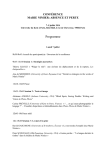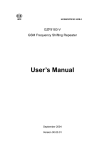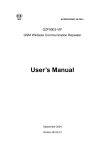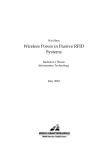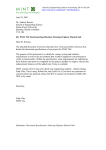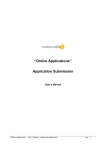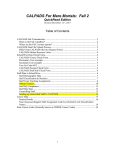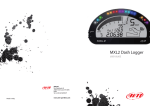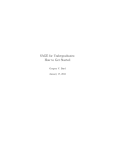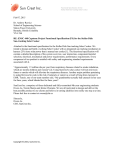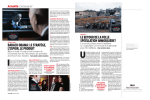Download Omar Khlif - Simon Fraser University
Transcript
School of Engineering Science 8888 University Drive Burnaby BC, V5A 1S6 [email protected] February 14, 2012 Dr. Andrew Rawicz School of Engineering Science Simon Fraser University Burnaby, BC V5A 1S6 Re: ENSC 440 Functional Specifications for Automated Attendance System Dear Dr. Rawicz, Attached to this letter is our team’s functional specification for an automated attendance system, regarding our 440 engineering science class. The project aims to design and implement a system that will take students attendance at university through automatic identification check and facial recognition. The objective of the functional specification is to present a set of high-level requirements for the system’s functionality. Our project manager and design engineers will use these specifications to effectively design our modules. Our company, Secure Com Systems consists of five talented engineers. Omar Khlif, Tahani Trigui, Oldooz Pooyanfar, Hongxin Dai, and Dong Geun Shin are all fourth-year engineering students majoring in computer, electronics and systems engineering. We will be delighted to hear from you in order to further discuss our functional specification. If you have any question or concern about our product, please contact me via email at [email protected]. Sincerely, Omar Khlif Chief Executive Officer Enclosure: Functional Specifications for Automated Attendance System Functional requirement for Automated attendance system Project Team Tahani Trigui Oldooz Pooyanfar Omar Khlif Hongxin Dai Dong Geun Shin Contact Person Oldooz Pooyanfar [email protected] Submitted to Dr. Andrew Rawicz - ENSC 440 Steve Whitmore - ENSC 305 School of Engineering Science Simon Fraser University Issued Date February 14, 2013 Revision 1.1 School of Engineering Science 8888 University Drive Burnaby BC, V5A 1S6 [email protected] Executive Summary As time progresses the academic institutions give more attention to the learning curve of the students. Insisting on ways to increase the time students spend in class learning from the instructors, some turn in to sign up sheets for taking attendance. Aside from that during exams each student’s identity needs to be checked in order to prevent any plagiarism. As the number of students grows each year and there needs to be more regulations and resources to control them. Secure Com Solutions (SCS) proposes a new more convenient way to take attendance using simple RFID readers and image processing. This will help instructors and TA’s to save time during exams and class, to avoid distraction, also to interpret better the data. The proposed solution by Secure Com Solutions (SCS) tries to address this issue by introducing a new way of taking attendance during exams and class. This will allow to first helping the instructor to check students’ identity, second to have an attendance record. Up to now, this is mostly done manually at the academic institutes. This technology is a step towards bettering the educational system by saving time and maybe encouraging students to attend classes. This document will cover the specification of the design for “Automated Attendance system”. The hand held device will have the capability of reading an RFID card and taking a picture of the student at the same time. This design includes two major basic design layers: software and hardware. The related software part of the system includes image processing and connecting to data base for RFID number comparison. The hardware aspect of the design will cover the RFID reader/ tag circuit and the camera connections. The document will go through a breakdown of each design spec and covering the requirements for the design. An important part of the design is testing. This document will also give the testing plan of the design. It will provide a test plan for testing and modifying the design. In summary the system has the following specifications: RFID reader/tag - used to check the students’ identity and providing the program with an associated picture with their number - the RFID system will be designed such that it follows all the safety regulations Camera and Image processing - after the RFID associating the number with a picture this program will double check their identity © 2013, Secure Com Solutions Page 3 School of Engineering Science 8888 University Drive Burnaby BC, V5A 1S6 [email protected] After testing and developing each section of the design, SCS plans to integrate the different parts and provide a simple prototype. Due to time constraints until April of 2013 the team has planned to produce a working prototype. © 2013, Secure Com Solutions Page 4 School of Engineering Science 8888 University Drive Burnaby BC, V5A 1S6 [email protected] List of figures Figure 1- Top level block diagram ................................................................................................... 9 Glossary SCS – Acronym; Secure Com Solutions RFID – Acronym; Radio Frequency identification The system – The SCS automated attendance system under development ID number – An identification of a particular student, each student has a unique number ISO – Acronym; International Organization of Standardization USB – Universal Serial Bus GUI – Graphical User Interface © 2013, Secure Com Solutions Page 5 School of Engineering Science 8888 University Drive Burnaby BC, V5A 1S6 [email protected] Table of Contents Executive Summary......................................................................................................................... 3 List of figures ................................................................................................................................... 5 Glossary ........................................................................................................................................... 5 1 2 3 4 Introduction ............................................................................................................................. 8 1.1 Scope ................................................................................................................................ 8 1.2 Intended Audience ........................................................................................................... 8 1.3 Classification..................................................................................................................... 8 System requirements .............................................................................................................. 9 2.1 System overview .............................................................................................................. 9 2.2 General requirements .................................................................................................... 10 2.3 Physical requirements .................................................................................................... 10 2.4 Electrical requirement .................................................................................................... 10 2.5 Environmental facts ....................................................................................................... 10 2.6 Standards........................................................................................................................ 11 2.7 Reliability and Durability requirements ......................................................................... 11 2.8 Safety requirements ....................................................................................................... 11 2.9 Performance requirements ............................................................................................ 11 RFID reader ............................................................................................................................ 12 3.1 General requirements .................................................................................................... 12 3.2 Physical requirements .................................................................................................... 12 RFID tag .................................................................................................................................. 13 4.1 General requirements .................................................................................................... 13 4.2 Physical requirements .................................................................................................... 13 5 Camera ................................................................................................................................... 13 6 Software................................................................................................................................. 14 7 User documentation .............................................................................................................. 14 8 System test plan .................................................................................................................... 15 © 2013, Secure Com Solutions Page 6 School of Engineering Science 8888 University Drive Burnaby BC, V5A 1S6 [email protected] 9 8.1 RFID reader ..................................................................................................................... 15 8.2 Software system and image processing ......................................................................... 15 Conclusion ............................................................................................................................. 17 10 Reference .............................................................................................................................. 18 © 2013, Secure Com Solutions Page 7 School of Engineering Science 8888 University Drive Burnaby BC, V5A 1S6 [email protected] 1 Introduction The Automated Attendance System can automatically capture student’s attendance base on the RFID and face recognition technology. The system is consisted of a camera, an RFID reader and tags, and a software solution. The camera will capture the image of the user when he/she passes the RFID card by the reader. The RFID reader will collect the information from the tag, digitizes it, and transmits it to the computer. The software gets the student information associated with the RFID tag, checks whether the student is enrolled in the class and compares the student’s photo with the image captured by the camera. With our Automated Attendance System, the lecturer can easily and automatically keep track of student attendance and can check that the student themselves are taking the exam. 1.1 Scope This document describes all functional requirements for the Automated Attendance System. It provides physical, electrical and environmental requirements, as well as reliability, durability and safety standards. These requirements fully describe the proof-of-concept model and the prototype system for reproduction. A development test plan is also provided for testing and implementation. 1.2 Intended Audience The functional specification document will be used by all members of the Secure Com Solution team throughout the design, building, and testing phases of the Automated Attendance System development. This document will be used to ensure all the design functions have been implemented, and the system works as in the proposed design. 1.3 Classification The following convention will be used to specify the type of functional requirement: [Rn-P] A functional requirement where ‘n’ is the functional requirement number and ‘P’ is the priority of the functional requirement. The priority is shown below: A. These requirements are high priority and are essential and necessary for the function of our system. B. These requirements are medium priority and are important for making a marketable device. C. These requirements are low priority and they represent fine tuning and refinements to our product. © 2013, Secure Com Solutions Page 8 School of Engineering Science 8888 University Drive Burnaby BC, V5A 1S6 [email protected] 2 System requirements 2.1 System overview The automated attendance system high level overview is modeled as shown in figure 1 below. FIGURE 1- TOP LEVEL BLOCK DIAGRAM The product design consists of three main sub-systems: The RFID reader, the camera and a software program. Due to time and budget constraints, the project will not be in its compact and ready to market form. All three parts will be separate but connected through Universal Serial Bus (USB) cables. A computer will be used instead of a microprocessor and a web camera will serve instead of an integrated camera. All students will have to scan their personal RFID tags. The unique ID is associated with the student account saved on the database. For the scan to be completed, the RFID reader will continuously transmits a 125 KHz carrier signal to power the passive RFID tag. After receiving the information from the tag, the receiver digitizes it and transmits it to the computer through © 2013, Secure Com Solutions Page 9 School of Engineering Science 8888 University Drive Burnaby BC, V5A 1S6 [email protected] a USB cable. The software solution will be responsible for extracting information related to the tag from the database. A picture of the student will appear on the screen. After scanning his or her card, the student will have to stand directly in front of the camera with a clear background (i.e.: no interference from any other person). The software program will be an executable file that will be launched by the user. Due to time constraint, the picture will not be captured automatically after reading an RFID tag. A bottom will be displayed on the screen to allow the user to take a picture. The captured picture will be saved on the database and displayed on the screen. The picture associated with the student saved on the database will be compared to the one captured by the camera. Image processing techniques will be used for comparison purpose. The user will be notified if an incompatibility occurs. The user will have the choice to either decline if the system fails or to proceed if the pictures do not actually match. 2.2 General requirements [R1-A] The system must read only one tag at a time and give enough time to take a picture and process it. [R2-B] The system needs to have a notification system for when it fails to read a tag or take a picture. [R3-C] The system may be manufactured as one wireless device . 2.3 Physical requirements [R4-C] The system must be compact and the RFID reader and the camera must be integrated in an easy to handle system. 2.4 Electrical requirement [R5-A] The RFID reader is powered with a battery. [R6-A] The computer is the power provider to the camera. 2.5 Environmental facts [R7-B] The system must operate at normal room temperature and humidity. [R8-B] The system has to remain dry at all times. © 2013, Secure Com Solutions Page 10 School of Engineering Science 8888 University Drive Burnaby BC, V5A 1S6 [email protected] 2.6 Standards [R9-A] The reader and the tag have to be compatible with ISO 18000-1 – Generic Parameters for the Air Interface for Globally Accepted Frequencies. [1] [R10-A] The reader must be compatible with Air Interface Protocol: EPC global ISO 18000-2 – for frequencies below 135 kHz. [1] 2.7 Reliability and Durability requirements [R11-A] The system should be impenetrable by unauthorized users. [R12-B] The system’s parts should be easy to access for repairs. [R13-B] The system should endure accidents (but not limited to) being dropped or smashed. 2.8 Safety requirements [R14-A] The system should not affect the health of the users. [R15-A] The system’s electrical components should be sealed away from users. [R16-A] The System shall not cause cancer or other medical defects for any user. 2.9 Performance requirements [R17-B] The system need to be able to process a student in less than 3 seconds. [R18-A] The unit needs to send the data to the main frame computer in less than 0.5secs. © 2013, Secure Com Solutions Page 11 School of Engineering Science 8888 University Drive Burnaby BC, V5A 1S6 [email protected] 3 RFID reader The RFID reader unit is the part of the system that reads the RFID tag on the student’s ID. It then will send that data to the computer for comparison to the list of students that is associated with their picture. 3.1 General requirements [R19-A] The reader has to recover any RFID tag within the range. [R20-A] The reader needs to send the tag numbers read to a computer. [R21-A] The reader need to be able to read the data in less than a 0.5secs. [R22-B] The reader should not interfere with any other RFID based device. [R23-B] The reader needs to cover a range of less than 10cm. [R24-C] The reader should be traceable if lost. 3.2 Physical requirements [R25-B] The reader should not weigh more than a few hundred grams. [R26-B] The reader’s size should not exceed 15cmx10cm. [R27-B] The components of the reader should not be visible and be in a closed casing. [R28-B] The reader needs to be easy to operate. [R29-C] The reader should be portable and easy to handle. © 2013, Secure Com Solutions Page 12 School of Engineering Science 8888 University Drive Burnaby BC, V5A 1S6 [email protected] 4 RFID tag 4.1 General requirements [R30-A] The tags must be passive, no battery required. [R31-A] The data on the tags should be persistent and have unique identification numbers. [R32-A] The RFID tags shall allow for an infinite number of uses. [R33-C] The tags shall be readable by the RFID reader within 10 cm even if placed in pockets, wallets, bags, or in close proximity to metal such as keys. 4.2 Physical requirements [R34-B] The tags must be as big as an identification card/credit card. [R35-B] The tags must weigh less than 10 grams. [R36-C] The tags must be waterproof and hard to break. 5 Camera [R37-A] The camera shall be a standard webcam for an acceptable performance. [R38-A] Camera shall be cheap and it shall not exceed our expected budget 30 dollars. [R39-B] The camera should have LED to help brighten the darker environment in order to maintain the picture brightness. [R40-C] Superior performance can be met by higher resolution that will increase precision. However it will slow down the processing time. 640x480 pixels minimal camera resolution can be used for face enrollment and recognition. [2] © 2013, Secure Com Solutions Page 13 School of Engineering Science 8888 University Drive Burnaby BC, V5A 1S6 [email protected] 6 Software [R41-A] The program will not handle more than one face per picture. [R42-A] The program runs on a Windows operating system. [R43-A] The program must not allow the user to take a picture before reading the scanned RFID tag. [R44-A] The program must not allow the user to modify any information stored in the database. [R45-A] The program must not allow more than one picture to be associated with the student profile. [R46-A] The program must allow the user to delete a taken picture. [R47-A] The program must read and save the picture transferred from the camera via USB. [R48-A] The program must read the tag information and use it to identify the student in the database. [R49-A] The computer will be connecting to only one RFID reader. [R50-B] The GUI interface will be aesthetically appealing and easy to use. [R51-B] The processing time of every picture will take less than 0.5 second. [R52-C] A compatibility layer such as WINE is needed to run the program on Linux platform . [R53-C] The program must compare the picture taken and the picture from the database with at least 90% accuracy. 7 User documentation The user documentation will give complete instructions on operating the device and fixing simple problems in just in case. The user documentation will contain complete safety information. User documentation will be written in English. User manual will cover non-technical details about the device for the user. The user technical manual will cover technical information and circuit diagrams for more technically trained audience. © 2013, Secure Com Solutions Page 14 School of Engineering Science 8888 University Drive Burnaby BC, V5A 1S6 [email protected] 8 System test plan The main idea behind the test plan consists of testing the individual parts separately on the first stage. Then merge all modules together step by step and do an extensive testing. 8.1 RFID reader The objective of this part is to detect the tag and transfer information associated with it to the computer. Given the distance constraint to assure no interference from other tags, the RFID reader needs to be tested with different distances. Once, we know the range, another tag will to be introduced at the same time. The RFID reader needs to detect only one tag at a time. Once the detection stage is done, the transfer stage will be tested. A USB port will be connected to the circuit. Using a USB cable, data will be transferred to the computer. The number read should match the unique number associated with the tag. Around 5 to 10 tags will be tested. 8.2 Software system and image processing The purpose of this module is to receive the incoming information, retrieve data from the database and compare two pictures. To be efficient the image processing will be implemented and tested in parallel with the other software parts. Once every part is working, the integration phase will be done and testing will be conducted. A database will be created and filled by some random information for testing purpose .The first testing step after that is to make sure that the connection between the program and the database is secure and reliable. Once the connection is made, a random number with the same format as the tag number will be used to access the database. The second step will be to store an image in the database and to retrieve it using the same number. Meanwhile, the image processing module will be implemented and tested with some random pictures. At this stage, both the image processing code and the communication code will be integrated and tested together. As soon as we assure that the system is working properly, the GUI will be taking care of. All feedback messages will be displayed to the user on the screen. As a final test, all parts software and hardware will be combined and extensively tested. The information received form the RFID reader will be used to access the database and the picture captured by the camera will be saved. Once reading information from both the RFID reader and the database is guaranteed to be working properly, reading from the camera will be tested. An alternation between reading the tag information and capturing a photo needs to be respected. © 2013, Secure Com Solutions Page 15 School of Engineering Science 8888 University Drive Burnaby BC, V5A 1S6 [email protected] Multiple scenarios will be experienced to ensure that the algorithm works properly and meets the requirements. One person scans his/her RFID tag , then get a picture from the camera One person scans his/her RFID tag and another person scans his/her RFID tag One person scans his/her RFID tag , then get a picture from the camera and another person gets a picture without scanning his/her tag One person scans his/her RFID tag and another person get a picture from the camera More than one person scan their tags at the same time In all the above scenarios the system should detect the acceptable from the unacceptable scenario and give feedback to the user. Once everything is working properly, system improvement and optimization will be taken into consideration. © 2013, Secure Com Solutions Page 16 School of Engineering Science 8888 University Drive Burnaby BC, V5A 1S6 [email protected] 9 Conclusion In Functional specification document, we clearly and concisely defined the functional requirements for our automated attendance system. Furthermore, these requirements, prioritized by a three step system, shape the development phases of our product. By the completion of each phase, from high priority requirements to the desirable requirements, the system will migrate from proof-of concept model to a marketable prototype. The proof of concept device is well under development and we are confident that the final product will be complete by April 14 as initially planned. © 2013, Secure Com Solutions Page 17 School of Engineering Science 8888 University Drive Burnaby BC, V5A 1S6 [email protected] 10 Reference [1] Matt Ward. Rob van Kranenburg. (May 2006) JISC Technology and Standards Watch “RFID: Frequency, standards, adoption and innovation”. www.jisc.ac.uk/media/documents/techwatch/tsw0602.doc [2] http://www.neurotechnology.com/face-image-recommendations-constraints.html [3] U.S. Department of Education, National Center for Education Statistics (2012). Digest of Education Statistics, 2011. [4] Stanca, Luca, The Effects of Attendance on Academic Performance: Panel Data Evidence for Introductory Microeconomics (July 2004). © 2013, Secure Com Solutions Page 18


















